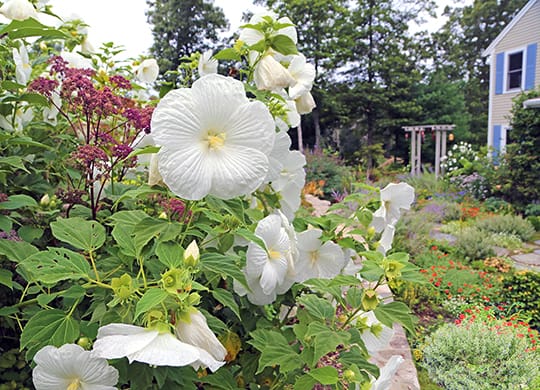A Gardening Life – February 7th
It’s off that I never came across hardy hibiscus early in my gardening years. Strange given how showy, reliable, and easy this perennial is. There weren’t as many varieties of Hibiscus moscheutos around then, but still…someone must have been growing them. These plants are as dependable as peonies and they flower later in the summer. If you have a large sunny spot for one or more, plant them and just stand back. Let me emphasize the word large. Unless you buy a dwarf cultivar, or the variety ‘Kopper King’, which is thinner, give this perennial plenty of room. Twirl around in a circle with your arms straight out: that’s the amount of space most hardy hibiscus will fill.
This plant is a good example of why we need to keep our eyes open in the landscape, however. After growing numerous varieties of H. moscheutos, three or four years ago I suddenly noticed that the plants’ foliage was beginning to look like Swiss cheese. The leaves were filled with holes and rapidly becoming lace. I wasn’t successful in my first attempt at finding the culprit. I looked under leaves and on stems but couldn’t spot what was doing the damage. Finally, a friend told me about the Hibiscus Sawfly Larva, Atomacera decepta. Yikes…another new insect to worry about.
It was no wonder that I couldn’t see the little buggers…they are very tiny and green. Fortunately an application of a product containing Spinosad is very effective for these larva; just spray it under the foliage at the first sign of damage. Now I know that in the Northeast this pest is active starting in July, right before the Hibiscus flowers, so I keep my eyes open for the first hole or two and spray immediately after seeing the first holes.
In an ever shrinking world where insects have become jet setters that travel from one continent to another, we need to be prepared for new and varied pests. Some of these will be as easy to deal with as the Hibiscus sawfly larva. Others, such as the Asian longhorn beetle, will be more problematic. All we can do is remain watchful and open minded, determined as possible not to do more harm with our treatments than the pest already does to the plants.

You can see a few holes on the leaves of this Hibiscus 'Blue River II' - I sprayed Spinosad under the leaves the day before this photo was taken. Had I not pointed out the holes, however, you probably wouldn't have noticed them because the flowers are so beautiful. Also in this photo is an Angelica archangelica - an unknown purple variety (not gigas) that self seeds around my gardens.
Sharing The Wealth
Tips for Growing Hardy Hibiscus
- It takes about three years for this plant to develop its full size, so don’t plant them too close to other perennials or shrubs. Assume that most hardy Hibiscus will grow to be four to five feet in diameter.
- Go light on the fertilizer. I apply a light amount of a general organic fertilizer in the spring, and that’s all. Plants that grow large and have big flowers often get too floppy when given more fertilizer, so keep them on a lean diet.
- These perennials come into the garden singing “Good Day Sunshine” – don’t make them sad by planting in less than five hours of dead-on sun including the noon hour.
- You can either cut the bare stems down in the fall or spring. Leave them until the foliage falls naturally, however, because the leaves have nice yellow color in autumn. The bare stems and seed pods are ornamental in the winter garden, so if you want a perennial that looks good in the snow, don’t trim the old stems back until early spring.
- These plants have no use for cool weather. Don’t expect hibiscus to break dormancy in the fall when all of your other plants are springing out of the ground. Hardy hibiscus waits until the ground and air are reliably warm before showing any growth. It’s not dead, it’s just biding it’s time until the heat is on.

